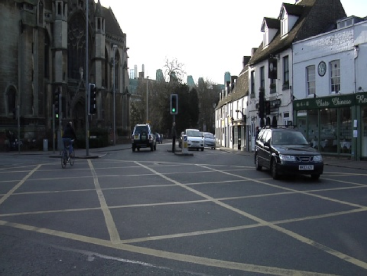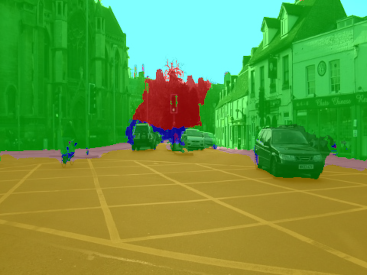PaddleSeg
PaddleSeg is an easy-to-use image segmentation library with a large pre-trained model zoo, supporting wide-range of practical tasks in Semantic Segmentation, Interactive Segmentation, Panoptic Segmentation, Image Matting, 3D Segmentation, etc. Custom docker images with additional tools are available from here:
https://github.com/waikato-datamining/paddleseg
Prerequisites#
Make sure you have the directory structure created as outlined in the Prerequisites.
Data#
In this example, we will use the CamVid-12 dataset, which consists of still images from dashcam videos from a city environment (12 different labels).
Download the dataset from the following URL into the data directory and extract it:
https://datasets.cms.waikato.ac.nz/ufdl/data/camvid12/camvid12-grayscale.zip
Once extracted, rename the grayscale directory to camvid-grayscale.
Now we have to convert the format from grayscale into indexed PNG, which PaddleSeg uses. We can do this by using the image-dataset-converter library. At the same time, we can split the dataset into train, validation and test subsets.
From within the applied_deep_learning directory, run the following command:
docker run --rm -u $(id -u):$(id -g) \
-v `pwd`:/workspace \
-t waikatodatamining/image-dataset-converter:0.0.7 \
idc-convert \
-l INFO \
from-grayscale-is \
-i "/workspace/data/camvid-grayscale/*.png" \
--labels unlabelled sky building pole road pavement tree signsymbol fence car pedestrian bicyclist \
--background 11 \
to-paddle-is \
-o /workspace/data/camvid-paddleseg-split \
--split_names train val test \
--split_ratios 70 15 15
Training#
For training, we will use the following docker image:
waikatodatamining/paddleseg:2.10.0_cuda11.8
Training and inference are possible on just a CPU as well (though much, much slower). For utilizing a CPU you can use the following docker image:
waikatodatamining/paddleseg:2.10.0_cpu
The training script is called paddleseg_train, for which we can invoke the help screen as follows:
docker run --rm -t waikatodatamining/paddleseg:2.10.0_cuda11.8 paddleseg_train --help
It is good practice creating a separate sub-directory for each training run, with a directory name that hints at
what dataset and model were used. So for our first training run, which will use mainly default parameters, we will
create the following directory in the output folder:
camvid12-paddleseg-unet
Before we can train, we will need to obtain and customize a config file. Within the container, you can find example configurations for various architectures in the following directory:
/opt/PaddleSeg/configs
Using the paddleseg_export_config command, we can expand and dump one of these configurations for our
own purposes:
docker run --rm \
-u $(id -u):$(id -g) \
--gpus=all \
-v `pwd`:/workspace \
-v `pwd`/cache:/.paddleseg \
-v `pwd`/cache/visualdl:/.visualdl \
-t waikatodatamining/paddleseg:2.10.0_cuda11.8 \
paddleseg_export_config \
-i /opt/PaddleSeg/configs/unet/unet_cityscapes_1024x512_160k.yml \
-o /workspace/output/camvid12-paddleseg-unet/unet_cityscapes_1024x512_160k.yml \
-c `cat data/camvid-paddleseg-split/labels.txt | wc -l` \
-t /workspace/data/camvid-paddleseg-split/data-train.txt \
-v /workspace/data/camvid-paddleseg-split/data-val.txt
NB: Number of classes is the number of labels plus background. For this dataset,
the background is explicitly labeled, so we can just use the number of labels in
the dataset (wc -l).
Kick off the training with the following command:
docker run --rm \
-u $(id -u):$(id -g) \
--shm-size=8g \
--gpus=all \
-v `pwd`:/workspace \
-v `pwd`/cache:/.paddleseg \
-v `pwd`/cache/visualdl:/.visualdl \
-t waikatodatamining/paddleseg:2.10.0_cuda11.8 \
paddleseg_train \
--config /workspace/output/camvid12-paddleseg-unet/unet_cityscapes_1024x512_160k.yml \
--save_interval 500 \
--do_eval \
--save_dir /workspace/output/camvid12-paddleseg-unet \
--iters 1000
NB: You may want to increase the number of iterations to produce a more accurate model.
Predicting#
Using the paddleseg_predict_poll script, we can batch-process images placed in the predictions/in directory
as follows (e.g., from our test subset):
docker run --rm \
-u $(id -u):$(id -g) \
--shm-size 8G \
--gpus=all \
-v `pwd`:/workspace \
-v `pwd`/cache:/.paddleseg \
-v `pwd`/cache/visualdl:/.visualdl \
-t waikatodatamining/paddleseg:2.10.0_cuda11.8 \
paddleseg_predict_poll \
--model_path /workspace/output/camvid12-paddleseg-unet/best_model/model.pdparams \
--config /workspace/output/camvid12-paddleseg-unet/unet_cityscapes_1024x512_160k.yml \
--labels /workspace/data/camvid-paddleseg-split/labels.txt \
--prediction_in /workspace/predictions/in \
--prediction_out /workspace/predictions/out
Notes
- The predictions can either be output in grayscale (default), bluechannel format,
indexed PNG or OPEX JSON (
--prediction_format). -
You can view the predictions with the ADAMS Preview browser:
Example prediction

